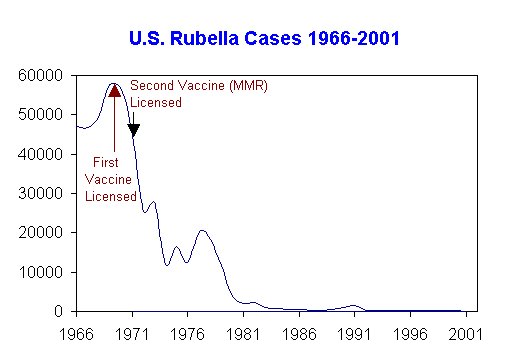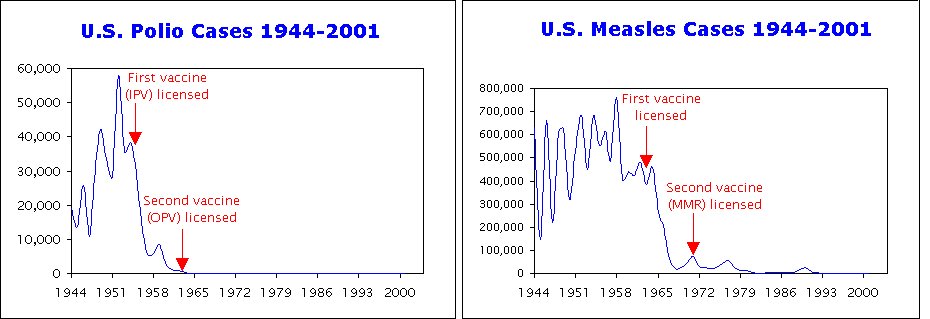The Center for Disease Control (CDC) runs a very important data-collection agency called the “Vaccine Adverse Effects Reporting System,” which is usually called the VAERS. This system serves an incredibly important function. It allows the CDC to monitor the safety of vaccines after they are licensed for use. The importance of this system has already been demonstrated, as it is responsible for the rotavirus vaccine being removed from the standard vaccination schedule after only a year of use. As I discuss in another article 1, the VAERS was able to show clinical investigators that there was a serious bowel obstruction associated with the rotavirus vaccine in a very small number of cases (1 case for every 11,073 doses of the vaccine). This side effect was too infrequent to be seen in the the clinical trials required for licensure, but the VAERS was able to identify it quickly. As a result, the rotavirus vaccine was pulled from the standard vaccination schedule. What is the VAERS? It is a system by which a medical doctor can report any adverse medical situation that occurs in one of his or her patients shortly after a vaccination. The doctor might not think that the adverse situation is due to the vaccination at all, but the doctor should still report it. When reports of serious medical situations come in, they are investigated by a team of clinical analysts to determine whether or not the situation is possibly related to a vaccination. If the team thinks that there is a possible relationship, further studies are done to determine whether or not any relationship actually exists. If a relationship between a vaccine and a serious medical condition is verified, the use of that vaccine is then questioned. This can lead to a vaccine being pulled from the standard vaccination schedule, as was the case with the rotavirus vaccine.
The VAERS, then, is an important tool used by serious medical scientists to monitor the safety of vaccines. As is the case with most things associated with real medical science, however, anti-vaccination advocates lie about the VAERS in order to try to scare parents. Consider the following quote2:
“The Federal government VAERS (Vaccine Adverse Events Reporting System) was established by Congress under the National Childhood Vaccine Injury Compensation Act of 1986. It receives about 11,000 reports of serious adverse reactions to vaccinations annually, which include as many as one to two hundred deaths, and several times that number of permanent disabilities.”
Note what this author is saying. He says that the VAERS receives about 11,000 reports of serious adverse reactions to vaccinations annually. However, that is an out-and-out lie. The VAERS does not receive reports of adverse reactions to vaccinations. It receives reports of medical conditions that follow vaccination. These medical conditions may or may not be an adverse reaction to a vaccine. In fact, the vast majority of them are not. However, that is not determined by the doctor who reports to the VAERS nor by the VAERS. Whether or not the medical condition is related to the vaccination is determined by the team of medical scientists who analyze the data as well as the investigators of any follow-up studies that are done.
A medical condition reported to the VAERS, then, is not necessarily an adverse reaction to a vaccination. It could just be something that happened close to the time of vaccination by sheer coincidence. However, anti-vaccination advocates are very happy to ignore that incredibly important distinction. They want to scare you, and a number like 11,000 serious adverse reactions per year does scare, even if it is an out-and-out-lie.
But wait a minute. Can there really be 11,000 serious medical conditions that occur after vaccination by sheer coincidence? Not really. It is difficult to quote the anti-vaccination literature without finding more than one lie in the quote. The author is not only lying about the idea that these conditions are vaccine-related, he is also lying about the number. The CDC produced an analysis3 of VAERS reports over the eleven-year period from January 1, 1991 to December 31, 2001. During that period, the total number of conditions reported to the VAERS averaged 11,700 per year. However, the vast majority of those conditions were not serious! Most of them included things like mild fever, hypersensitivity at the injection site, rash, etc. According to the report, only 14.2% of the conditions reported were serious. Thus, the real number of serious conditions reported to the VAERS each year is not 11,000. It is roughly one-tenth that, or 1,700 (1,661 annually during the eleven-year period in the study).
Okay. Now that we have sifted through yet another lie and found the truth, let’s ask the correct question. Can there really be 1,700 serious medical conditions that occur each year after vaccination as a result of sheer coincidence? The answer is absolutely yes. After all, millions of vaccinations are given, and thousands of serious medical conditions occur in children every year. By sheer coincidence, then, some of those serious medical conditions will follow vaccination, even though they are not related to it in any way.
The best way to illustrate this us by example. Consider Sudden Infant Death Syndrome, which is usually called SIDS. We know for a fact that children who get the DPT vaccination are actually less likely to die of SIDS than those that do not get the vaccination. Not only do serious studies demonstrate this to be the case, we actually know the biochemical mechanism by which the DPT vaccination protects against SIDS. 4 As a result, we know for sure that the DPT vaccine does not cause SIDS. It actually protects a child to some degree from SIDS. Nevertheless, SIDS cases after DPT injection continually get reported to the VAERS every year, despite the fact that we know that the DPT vaccine actually protects against SIDS. Why do the deaths get reported to the VAERS? Sheer coincidence. Let’s look at some numbers so that you can see how such coincidences can occur.
Each year, there are 1.39 SIDS deaths per 1,000 children in the United States. Each year, there are 4.1 million births in the United States.5 Since there are 1.39 SIDS deaths per 1,000 live births each year and 4.1 million births annually, you can work out the numbers to find that there are 15.6 SIDS deaths each day. Now, if all of these children get the DPT, there would need to be 12.3 million doses of the DPT, since each child needs three doses. This works out to 33,698 doses each day. What does this tell us? This tells us that on any given day, the fraction of children under one year of age that are getting the DPT is 33,698 / 4,100,000, or 0.00822.
Now, if there are 15.6 SIDS deaths each day, and the fraction of all children less than one year old getting the DPT is 0.00822, then 0.00822 x 15.6 = 0.1282 children will die of SIDS on the same day as their DPT shot by coincidence alone. This works out to 46.8 deaths each year. Thus, by sheer coincidence, there will be 46.8 SIDS deaths that occur on the same day that the child gets the shot. If all doctors report this to the VAERS, then the VAERS will have 46-47 SIDS deaths each year, even though the DPT vaccine actually protects against SIDS!
As you can see, then, simply discussing what has been reported to the VAERS is meaningless. There is no way to separate the coincidental deaths (and other medical conditions) from the ones that are caused by the vaccine. To do that, it takes detailed studies. Sometimes, those studied find a link (as was the case with the rotavirus vaccine), but most of the time, they do not.
The sad part of this tale is that the CDC makes it very clear in all of its publications that a condition reported to the VAERS is not necessarily vaccine-related. For example, here is what the CDC has on its opening page to the web version of the VAERS6:
“In some media reports and on some web sites on the Internet, VAERS reports are presented as verified cases of vaccine deaths and injuries. Statements such as these misrepresent the nature of the VAERS surveillance system.” (Emphasis theirs)
In order to reach the data, you must click a link that says you have read and understood this statement. Thus, the anti-vaccination people who report VAERS conditions as vaccine-related are either lying about what they have read, or they are parroting others and have not checked out the facts for themselves. Either way, it should give you some indication of how seriously you should take such writings!
References
1. See The Pharmaceutical Companies Do Not Control the Scientific Research on Medicines
2. Rev Alan Phillips, “Dispelling Vaccination Myths” Available at whale.to, one of the more popular anti-vaccination websites
3. Morbidity and Mortality Weekly Report Surveillance Summaries Vol 52, Jan 24, 2003 Available online
4. See Vaccines Actually Protect Against Sudden Infant Death Syndrome (SIDS)
5. Felicia McGurren, “CDC Officials Help Physicians Answer DPT-Safety Questions.” AAP News, March 1995, p. 9.
6. See The Web Portal to VAERS data
Dr. Wile is not a medical doctor. He is a nuclear chemist. As a result, he does not dispense medical advice. He simply educates the public about scientific issues. Please consult a board-certified medical doctor before making any medical decisions for yourself or your family.



